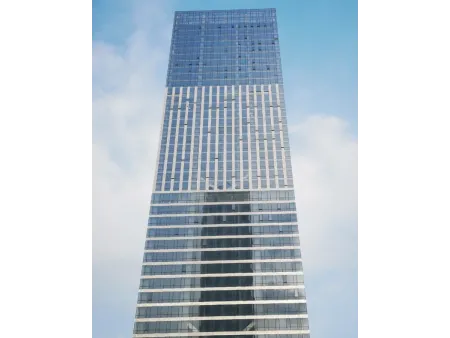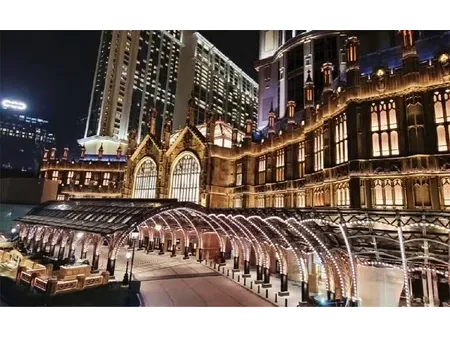Laminated Glass
Laminated Glass consists of two or more glass layers, permanently bonded together using one or more interlayers, such as PVB or SGP, through high-temperature and high-pressure processes. The glass and the interlayer are permanently fused into a composite product, providing enhanced safety and performance. The maximum size of laminated glass can reach 3300mm × 12000mm.
Common interlayer materials for laminated glass include PVB, SGP, EVA, and PU. There are also special laminated glass types, such as colored interlayers, SGX printed interlayers, and XIR LOW-E interlayers, as well as decorative and functional laminated glass with embedded items like metal mesh, metal plates, or PET materials. Even if the glass breaks, the fragments remain adhered to the interlayer, ensuring the surface stays smooth and intact. This helps prevent injuries from flying shards and falling pieces, ensuring personal safety.
-
Safety and Durability:Laminated glass prevents shards from flying out upon impact, maintaining the integrity of the glass and reducing the risk of injury. It provides excellent safety and structural stability, even in the event of breakage.
-
Customized Functionality: Laminated glass can be customized with various interlayers such as PVB, SGP, EVA, and others, allowing for a wide range of design and performance options. This includes UV protection, sound insulation, and impact resistance.
-
High Transparency and Aesthetic Appeal: The interlayer material, such as PVB, maintains the clarity and transparency of the glass, while also offering color options or decorative elements, making it suitable for aesthetic applications in architecture.
-
Sound Insulation and UV Protection: Certain types of laminated glass, especially those with special interlayers, provide sound insulation and UV protection, making them ideal for use in sound-sensitive environments or places needing protection from harmful UV rays.
Laminated glass used in this project features:
- 15mm Ultra-Clear Tempered Glass 1.52mm PVB (Transparent)
- 0.05mm XIR Film 1.52mm PVB (Transparent)
- 15mm Ultra-Clear Tempered Glass
- 15mm Low Iron FT 1.52mm PVB
- 0.05mm XIR Film 1.52mm PVB 15mm Low Iron FT
What is the difference between PVB and SGP laminated glass?
The main difference between PVB laminated glass and SGP laminated glass lies in the performance, strength, durability, and applications of the interlayer material used.
What are the benefits of using laminated glass in architecture?
Laminated glass offers several advantages, including impact resistance, excellent sound insulation, UV protection, fire resistance, wind pressure resistance, and energy efficiency.
Can laminated glass be used for bulletproof applications?
Yes, laminated glass can be used in bulletproof applications, but it requires special design and the use of specific materials and processes to meet the necessary standards.
What is the maximum size available for laminated glass?
The maximum size for laminated glass can reach 3300mm × 12000mm.
How does laminated glass improve safety in vehicles?
Laminated glass in vehicles can prevent glass shattering, enhance impact resistance, increase the structural strength of windows, block UV rays, reduce excessive temperatures, and lower noise levels.
What are some decorative applications of laminated glass?
Whether used in home design, building facades, or commercial displays and artistic decorations, laminated glass offers designers a wealth of creativity and flexibility for various applications.
Is laminated glass effective for noise reduction?
Yes, laminated glass consists of two or more glass layers with an interlayer (usually PVB), which not only enhances the structural strength of the glass but also effectively absorbs and dampens the transmission of sound waves.
Can laminated glass be used in high-security environments?
Laminated glass is highly effective in high-security environments due to its impact resistance and durability.
What types of interlayers are used in laminated glass?
Common interlayers used in laminated glass include PVB, SGP, EVA, and TPU.
What are the advantages of using laminated glass in curtain walls?
The main advantages of laminated glass in curtain walls include excellent sound insulation, energy efficiency, heat insulation, UV protection, and strong weather resistance and durability.
How is laminated glass used for sound insulation?
Laminated glass is widely used for sound insulation due to the damping and sound-absorbing properties of the interlayer. It is especially suitable for noise-sensitive areas or places requiring privacy protection. If acoustic-grade laminated glass is used, the sound insulation performance can be further improved, making it an ideal material for high-quality building designs.
Choose our high-performance laminated glass for superior safety, sound insulation, UV protection, and energy efficiency. Perfect for architectural and automotive projects, our glass offers customization to meet your design needs. Ready to bring your vision to life? Contact us today to learn more about how laminated glass can support your project!




